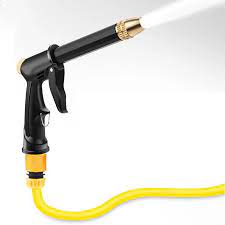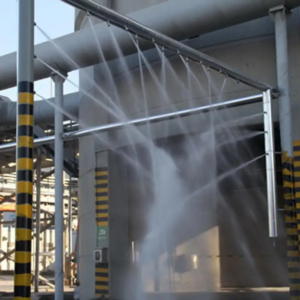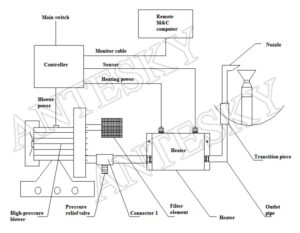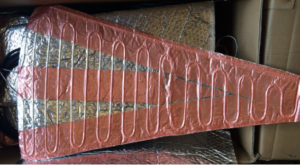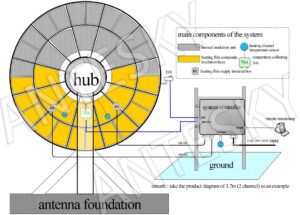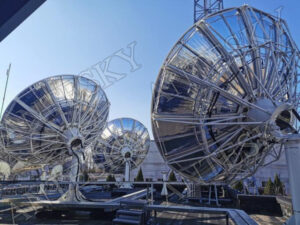
As we know that antenna is transmitted signal via microwave, which is effected by environment conditions.Antenna efficiency will be deducted when antenna reflector is covered by snow. In the mean time, high noise temperature will disturb antenna receiving and transmitting.In order to assure antenna efficiency and to lower noise temperature, it is required to install anti-ice and de-ice device on antenna reflector, which can significantly eliminate the influence of snow on the antenna performance.
1. Influence of snow attenuation on satellite signals of satellite antenna
Under normal circumstances, snowfall will not cause significant attenuation of satellite signals, but the process of snow accumulation and snow melting will cause the signal to be absorbed, from strong to weak, or even to be greatly weakened. The satellite signal is an important factor affecting the transmission of the signal source of the uplink station and the reception quality of the ground station. The oral field distribution function of modern satellite communication antennas is the result of a compromise between high gain, low sidelobe characteristics, and low antenna noise temperature. The more uniform the amplitude and phase of the oral field distribution function, the higher the antenna gain. During the snow melting process, the antenna feed and the uneven snow on the main reflector surface produce different scattering and absorption of electromagnetic waves, which is equivalent to seriously destroying the uniformity of the distribution function of the mouth surface field of the satellite antenna. The antenna gain is reduced; at the same time, the noise temperature of the antenna is also increased, the EIRP value of the uplink or the G/T value of the receiving system will be greatly reduced, which will affect the transmission quality of the satellite signal. Due to naturalization snow generally lasts longer. Therefore, the satellite uplink station must take active de-ice measures.
2. Requirements of de-icing system device
In practical application, the de-icing system device should be with high reliability,sample structure , easy installation and maintenance and delicate appearance. Also, the antenna electrical performance can not be effected such as antenna reflector accuracy will be reduced due to antenna surface deformation when new equipment added.
3. Several de-icing methods for satellite antenna
3.1 De-ice by manual operation
De-ice by manual operation refers to the use of snow rakes and other tools by the staff to remove snow directly on surface by sweeping, shoveling, etc. There are great safety hazards in actual work, and it is difficult to remove snow in time and not completely; especially for large-diameter antennas, there is a certain risk for personnel to operate on it, and special attention should be paid to the personal safety of the staff. Therefore in actual work, it is basically not recommended to remove snow in this way.
3.2 Water flushing method for de-icing of satellite antenna
3.2.1 High pressure water gun flushing
At present, many satellite stations use the flushing method to clean the snow on the antenna. The main disadvantages are as follows.
The water gun water pressure is large, which poses a great threat to the feed film (the damage to the antenna feed film will affect the uplink transmission);
The effect of de-ice cannot be achieved due to the low pressure of water gun; the high-pressure water gun has a large reaction force, and the physical fitness requirements of the snow rushing personnel are high; because the uplink antennas are all large-diameter antennas, the distance from the ground is high, and the snow rushing personnel work at high altitudes in snowy days. It is easy to cause safety problems; More personnel are needed to flush the snow; heavy snow cannot be cleaned up in time at night, which greatly affects the transmission of satellite signals.
Fig.1 High pressure water gun
3.2.2 Automatic water spraying method(cold water)
The automatic water spraying method commonly used in low-latitude areas is to install multiple water pipes around or in the middle of the antenna, and connect all the water pipes to a booster pump on the ground. When it encounters snow, turn on the water pump, and wash the surface of the antenna with water to remove snow. However, if the antenna surface cannot be completely cleaned in time in ice and snow weather, it will lead to attenuation of the uploaded satellite signal, which will seriously affect the strength of the received signal. In addition, the surface of the antenna is often washed by water, which is easy to rust, and has the following disadvantages:
It is necessary to frequently check whether there is water in the water pipe; after each snow flush, the water pipe must be emptied to prevent the water pipe from freezing and bursting; the staff needs to climb up to check the water pipe head, because the smooth surface of the antenna can easily cause casualties; the effect of ice and de-ice depends on heavy of ice or snow; the installation and maintenance costs are relatively large.
Fig.2 Water spraying method for reference
3.2.3 Improved automatic water spray method (hot water)
The method of using hot water to flush the antenna is to heat the water on the basis of automatic water spray, aiming at the antenna and the reflective surface. No matter how big the snow is, the snow on the antenna will be washed off very quickly, and the antenna surface will not be frozen. The de-ice speed is improved and the quality of satellite signal transmission is guaranteed. In this way, the effect of removing ice and snow is related to the size of the hot water storage tank, the ambient temperature and the severity of ice and snow, and the area and space occupied by the water storage tank as well as the method of generating hot water are also required. The actual situation should be considered before installation.
3.3 Blower blowing method used for antenna stations in high latitude regions
Most of the snow in the north at high latitudes is dry snow, which is not easy to stick to the surface of the antenna. A blower device is installed next to the antenna and the working principle as follows. During the snowing process, a high-power fan is used to pass through the horn-shaped tuyere, and the air curtain formed by the fan is used to blow away the snowflakes in real time, so that the snowflakes drift to the outside of the satellite antenna feed and reflector, preventing them from falling on the reflector of the antenna. The advantage of using blower to remove snow is to protect the feed. It is suitable for use in cold and snowy areas in northern high latitudes. Using a high-power blower to blow snow is better in dry and cold conditions, but snow has a certain viscosity factor, especially in rain and snow. In the weather, this method cannot completely clear the snow, resulting in the attenuation of the upload satellite signal, which seriously affects the received signal; another reason is that when the blower wind volume is large enough, it may cause a slight swing of the surface antenna, which will eventually affects the accuracy of the earth station on the satellite and the receiving accuracy of the ground receiving station. This method works well in high latitude northern areas, but the installation cost is high; and in the middle and low latitude southern areas, it is not suitable for use in the south because of the wet snow with high viscosity. The principle of wind blowing de-ice is shown in Fig. 4.
Fig.4 Blower
3.4 Electric heating film method for satellite antenna de-icing
The principle of the electric heating film for de-icing is to lay an electric heating element on the back of the satellite antenna reflector to quickly melt the snow , and allow the snow water to be drained cleanly from the drainage holes, and there is no attenuation of the signal, which is faster and more thorough than the above mentioned manual de-ice solutions.
At present, the electrothermal film snow melting method is commonly used, which adopts the latest heating materials and temperature control technology, and can monitor the environmental conditions around the antenna in real time and around the clock. When the system detects that there is snow or ice on the antenna surface, the system can start up quickly, so that the snow or thin ice on the antenna surface melts quickly and is suitable for long-term operation, and the system has a pre-heating function. therefore. The system not only effectively eliminates the impact of snowfall and icing on the performance of satellite antennas, but also ensures smooth communication links for users and effectively improves system availability. And the equipment is simple, easy to install, and does not need to modify existing equipment, so as to meet the needs of domestic satellite communication ground station users for satellite communication antenna snow melting devices, and can be widely used in receive only, satellite communication C-band, Ku-band and other satellite antennas of different diameters. Based on many years of experience, this device is durable and can be extended to the market. If interested, please contact us for more technical information.
Our 6.2m and 7.3m C&KU dual band antenna project in Kazakhstan were equipped with such electrothermal film of de-icing system.
The basic realization principle is the same as the electric blanket used in winter in high latitude regions, that is, the heating layer of the electric blanket avoids the ribs on the back of the panel, and is directly fixed on the back of the antenna reflector panel, with a thermal insulation layer and a fixed plate on the outside. Control the temperature of the electrothermal layer in ice and snow weather to remove snow and ice.
Diagram of De-ice system principle
Features of electric heating film to de-ice for satellite antenna
- Flexible silicone rubber heating film (with thermal insulation material), high heating efficiency, power saving and long life;
- Dedicated temperature control logic and unique snow and ice detection technology;
- Special system component installation design, easy to install on site;
- In snowfall, it does not affect the normal operation of the antenna. The system receives the beacon down by no more than ldB.
- Provide a variety of control modes to adapt to various working environments, including the following modes.
-Constant temperature mode: the antenna temperature is guaranteed to be stable;
-Power limit mode: The antenna is heated cyclically to ensure that the power does not exceed the limit value.
-Automatic mode: When the total power supply exceeds the total power supply, it will automatically switch from constant temperature mode to power limit mode.
-Forced heating mode: physical switch, manual switching of forced heating.
By analyzing the main technologies, advantages and disadvantages of several satellite antenna snow melting devices commonly used at present, it can be found that snow removal methods have their own characteristics, as shown in the following table.
| Method | Principle | Advantage | Disadvantage | Effect |
| de-ice by manual operation | / | Easy operation | 1. Need to remove snow many times;
2. More personnel are required; 3. It is easy to cause security problems. |
Eye observation |
| de-ice by Water flushing | High pressure water gun flushing | 1. It is convenient to take water;
2. The operation is simple. |
1. The size of the water column of the water gun should be controlled at all times;
2. Need remove snow many times; 3. More personnel are required; 4. It is easy to cause security problems. |
/ |
| Improved automatic water spray | 1. Simple structure
2. Easy operation 3. Low cost of maintenance |
1. It is necessary to check the nozzles at high places frequently.
2. The water pipe must be emptied after snowing; 3. The booster pump needs to be checked in time; 4. The antenna surface is easy to rust under a long time. 5. Hot water needs to be used, which should be heated in advance and have water storage space. |
||
| Blower | Blower of hot air circulation | 1. The heating and snow melting speed is fast, and the temperature of the antenna reflector is uniform;
2. Simple structure; 3. Safe to use; 4. Will not interfere with satellite signals. |
1. The blower is larger in size
2.Installation is complicated and the project is huge and complex; 3. Equipment maintenance is not easy |
In the beginning, the snow melting time is long. Unsuitable for complex weather. |
| Electrical heating film of antenna reflector | Heating Wire | Simple, fast and thorough | 1. Easy to leak electricity;
2. The power consumption of the heating wire is large; 3. Easy to burn |
High risk, not recommend |
| Heating Film | 1. Simple structure;
2. Easy to operate; 3. High heating efficiency; 4. Special temperature control; 5. The operation does not affect the normal operation of the antenna; 6. Adapt to various working environments; 7. Various control modes. |
High installation requirements | The thermal efficiency is very high; it can melt snow quickly and heat evenly; it can remove a thousand snows at one time. Can work continuously. Suitable for all weathers. Automatic management. can be promoted. |
4. Conclusion
In actual design, antenna site selection needs to be considered like location, antenna site dimension and installation conditions. In general, electrical heating film is the best way to remove snow, which can greatly to make antenna much more stronger to prevent snow and ice disaster. and the normal satellite communication process will be further guaranteed. Welcome to talk with Antesky if you have further advice or questions about de-icing devices. Thanks!
Here is our email address: sales@antesky.com

